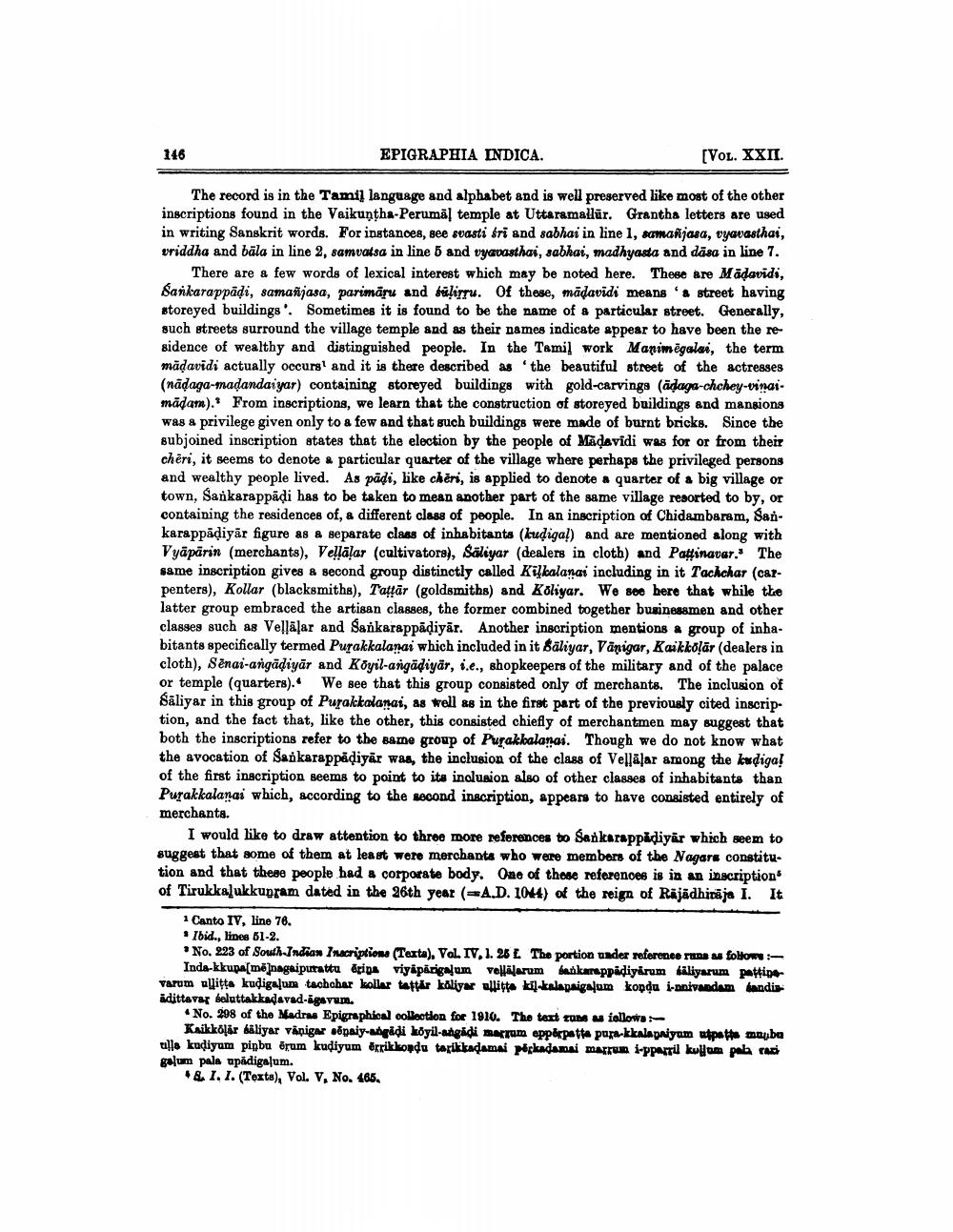________________
146
EPIGRAPHIA INDICA.
[VOL. XXII.
The record is in the Tamil language and alphabet and is well preserved like most of the other inscriptions found in the Vaikuntha-Perumal temple at Uttaramallür. Grantha letters are used in writing Sanskrit words. For instances, see svasti eri and sabhai in line 1, samañjasa, vyavasthai, vriddha and bāla in line 2, samvatsa in line 5 and vyavasthai, sabhai, madhyasta and dāsa in line 7.
There are a few words of lexical interest which may be noted here. These are Mädavidi, Sarkarappādi, samañjasa, parimāru and salirru. Of these, mādavidi means 'a street having storeyed buildings'. Sometimes it is found to be the name of a particular street. Generally, such streets surround the village temple and as their names indicate appear to have been the residence of wealthy and distinguished people. In the Tamil work Manimegalai, the term mādavidi actually occurs' and it is there described as 'the beautiful street of the actresses (nädaga-madandaiyar) containing storeyed buildings with gold-carvings (ādaga-chchey-vingimādam). From inscriptions, we learn that the construction of storeyed buildings and mansions was a privilege given only to a few and that such buildings were made of burnt bricks. Since the subjoined inscription states that the election by the people of Madavidi was for or from their cheri, it seems to denote particular quarter of the village where perhaps the privileged persons and wealthy people lived. As pädi, like cheri, is applied to denote a quarter of a big village or town, Sankarappādi has to be taken to mean another part of the same village resorted to by, or containing the residences of, a different class of people. In an inscription of Chidambaram, Sankarappadiyar figure as a separate class of inhabitants (kudigal) and are mentioned along with Vyāpärin (merchants), Vellalar (cultivators), Saliyar (dealers in cloth) and Pakinavar." The same inscription gives & second group distinctly called Kifkalanai including in it Tachchar (carpenters), Kollar (blacksmiths), Tattār (goldsmiths) and Koliyar. We 800 here that while the latter group embraced the artisan classes, the former combined together businessmen and other classes such as Vellälar and Sarkarappādiyār. Another inscription mentions a group of inhabitants specifically termed Purakkalanai which included in it Saliyar, Vänigar, Kaikkoļär (dealers in cloth), Senai-angādiyār and Koyil-angādiyar, i.e., shopkeepers of the military and of the palace or temple (quarters). We see that this group consisted only of merchants. The inclusion of Saliyar in this group of Purakkalanai, as well as in the first part of the previously cited inscription, and the fact that, like the other, this consisted chiefly of merchantmen may suggest that both the inscriptions refer to the same group of Purakkalanai. Though we do not know what the avocation of Sarkarappadiyar was, the inclusion of the class of Vellāļar among the kudiga! of the first inscription seems to point to its inclusion also of other classes of inhabitants than Purakkalanai which, according to the second inscription, appears to have consisted entirely of merchanta.
I would like to draw attention to three more references to Sankarappadiyar which seem to suggest that some of them at least were merchants who were members of the Nagare constitution and that these people had a corporate body. One of those references is in an inscriptions of Tirukkalukkupram dated in the 26th year (=A.D. 1044) of the reign of Rajadhiraja I. It
1 Canto IV, line 76. * Ibid., lines 61-2.
No. 223 of South Indian Inscription. (Texta). Vol. IV, 1.20 L The portion under reference ranem follow
Inda-kkupa[mo]nagaipurattu arida viyapårigalum vellälarum bankamppadiyirum faliyarum pertine varum allitta kudigalum tachohar kollar tattar kaliyar allitta kilkalapaigalum kopdu innivandam kandis adittavar beluttakkadavad-agavum.
No. 208 of the Madras Epigraphical collection for 1910. The text M M iollow
Ksikkölär bäliyar vänigar sopaiy-angadi köyil-angadi marrum epperpatta pura-kkalapaiyum atpathe maybe alla kudiyum pipbu örum kudiyum Orrikkondu tarikkadamai popkadamai marrun i-ppari kufom pola tai galum pala upädigaļum.
& 1. 1. (Texte), Vol. V, No. 465.




